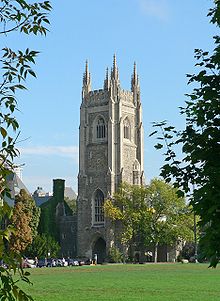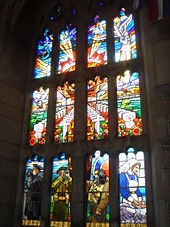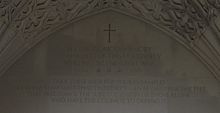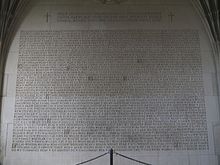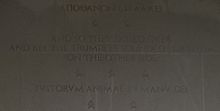The Peace Tower is a focal bell and clock tower sitting on the central axis of the Centre Block of the Canadian parliament buildings in Ottawa, Ontario. The present incarnation replaced the 55-metre (180 ft) Victoria Tower, after the latter burned down in 1916, along with most of the Centre Block; only the Library of Parliament survived. It serves as a Canadian icon and had been featured prominently on the Canadian twenty-dollar bill, directly adjacent to the depiction of Queen Elizabeth II, until the change to polymer.
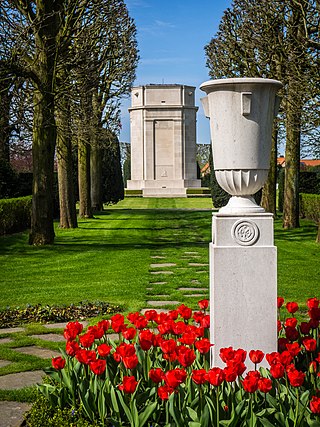
Flanders Field American Cemetery and Memorial is a World War I cemetery in the city of Waregem, Belgium. Originally a temporary battlefield burial ground, Flanders Field American Cemetery later became the only permanent American World War I cemetery in Belgium. The Flanders Field American Cemetery commemorates 411 service members of the United States Armed Forces of which 368 are interred. The Walls of the Missing inside the chapel venerates 43 missing service members.
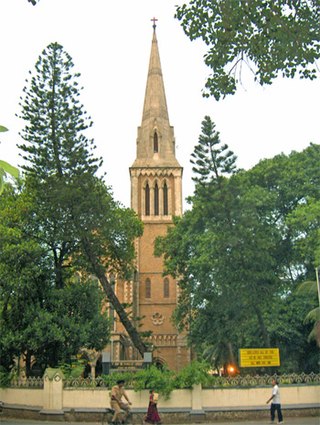
The Church of St John the Evangelist, better known as the Afghan Church, is a church of Anglican heritage, that belongs to the Mumbai diocese of the Church of North India. Located in Mumbai, Maharashtra, India, it was built by the British between 1847 and 1858 to commemorate the dead of the First Afghan War and the disastrous 1842 retreat from Kabul. Memorials at the rear of the nave also record casualties from the Second Anglo-Afghan War. The foundation stone was laid in 1847; it was consecrated in 1858, and work on the steeple finished in 1865.

The National War Memorial of New Zealand is located next to the Dominion Museum building on Buckle Street, in Wellington, the nation's capital. The war memorial was dedicated in 1932 on Anzac Day in commemoration of the First World War. It also officially remembers the New Zealanders who gave their lives in the South African War, World War II and the wars in Korea, Malaysia and Vietnam.

Cathedral Church of St Michael and St George serves as the Roman Catholic cathedral for the Bishopric of the Forces. Located on Queens Avenue in Aldershot, England, the building was originally intended to be the principal church for the Anglican chaplaincies of the British Army but since 1973 it has been the seat of the Roman Catholic Bishop of the Forces.

George Harold Baker was a lawyer, political figure, and soldier from Quebec, Canada. He represented Brome in the House of Commons of Canada from 1911 to 1916 as a Conservative Member of Parliament.
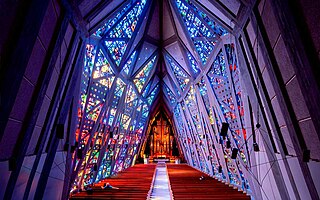
The First Presbyterian Church of Stamford is a church in Stamford, Connecticut designed by architect Wallace K. Harrison. Nicknamed the Fish Church for its unusual shape. The interior of the church contains a shimmering stained glass 60-foot-tall nave. it is a unique example of modernist architecture, and an architectural landmark. Its 260-foot-tall (79 m) Maguire Memorial Tower holds a 56-bell carillon. The building was designated a National Historic Landmark for its architecture in 2021, and the church is an active congregation of the Presbyterian Church (USA).

St Alkmund's Church is an active Anglican parish church in Whitchurch, Shropshire, England. By tradition, this church was founded in the 900s CE by the Saxon Queen Æthelflæd. Certain sources suggest that the saint to whom it is dedicated, St. Alkmund, (the son of Alhred, King of Northumbria, was first buried in Whitchurch.

St George's Cathedral is the Anglican cathedral in Cape Town, South Africa, and the seat of the Archbishop of Cape Town. St. George's Cathedral is both the metropolitical church of the Anglican Church of Southern Africa and a congregation in the Diocese of Cape Town.

Norwood Memorial Municipal Building is a historic building located in Norwood, Massachusetts, United States.
During World War II, the Netherlands was the scene of five years of continuous air warfare between the Allied and the Nazis as the Netherlands lies en route from England to Germany and was designated and built up as the foremost line of Nazi air defence of Germany. Also, in 1944 there was heavy land fighting during the largest Allied airborne attack of the WWII in the south and east of the country in 1944–45. Thousands of airmen, soldiers and others of many nations were killed, and their war graves in some 4,000 locations are in the care of the Dutch War Cemetery Organisation.

St Mary's Church is a redundant Anglican church in St Mary's Place, Shrewsbury, Shropshire, England. It is recorded in the National Heritage List for England as a designated Grade I listed building, and is under the care of the Churches Conservation Trust, the Trust designated St Mary's as its first Conservation Church in 2015. It is the largest church in Shrewsbury. Clifton-Taylor includes the church in his list of 'best' English parish churches.

St Mary's Church is in the village of Acton Burnell, Shropshire, England, and stands near the ruins of Acton Burnell Castle. It is an active Anglican parish church in the deanery of Condover, the archdeaconry of Ludlow, and the diocese of Hereford. Its benefice is united with those of St Andrew and St Mary, Condover, St Mark, Frodesley, and St Michael and All Angels, Pitchford. The church is recorded in the National Heritage List for England as a designated Grade I listed building.
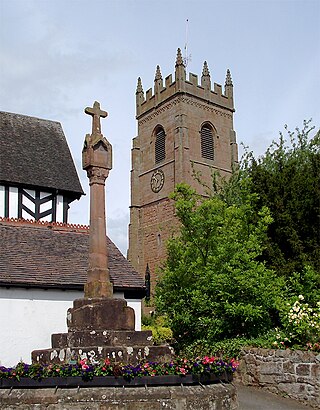
All Saints Church is in the village of Claverley, Shropshire, England. It is an active Anglican parish church in the deanery of Bridgnorth, the archdeaconry of Ludlow, and the diocese of Hereford. Its benefice is united with that of Holy Innocents, Tuck Hill. The church is recorded in the National Heritage List for England as a designated Grade I listed building.

St. Peter's Church is in the village of Edgmond, Shropshire, England. The church is an active Anglican parish church in the deanery of Edgmond and Shifnal, the archdeaconry of Salop, and the diocese of Lichfield. Its benefice is united with those of St Chad, Kynnersley, and St Lawrence, Preston upon the Weald Moors. The church is recorded in the National Heritage List for England as a designated Grade I listed building.

St Andrew's Church is a heritage-listed Seventh Day Adventist Church church at the corner of Maryborough and Woongarra Streets, Bundaberg Central, Bundaberg, Bundaberg Region, Queensland, Australia. It was designed by Lange Leopold Powell and built from 1931 to c. 1940. It was added to the Queensland Heritage Register on 3 August 2004.

University College, historically known as the Arts Building, is an academic building of the University of Western Ontario on its main campus in London, Ontario. The building has become an iconic symbol of the university, as well as a prominent landmark in the city of London. The building sits atop a hill and faces the Thames River. Along with the Physics and Astronomy Building, University College is one of the first buildings that was built on the present campus in 1922. The building currently houses the Faculty of Arts and Humanities.

Alexis Hannum Helmer was killed in battle during the Great War while serving with the 2nd Battery, 1st Brigade, Canadian Field Artillery. He is known as being part of the inspiration for "In Flanders Fields" through his friendship with John McCrae.

St John's Kirk is a church in the Scottish city of Perth, Perth and Kinross. Of Church of Scotland denomination, it is located in St John's Place, just southeast of the city centre. It stands on the former site of a church dating to 1126. Today's structure, built around 1448, is a Category A listed building. The church is most noted for being the site of John Knox's 1559 sermon against idolatry, which began the Scottish Reformation.
